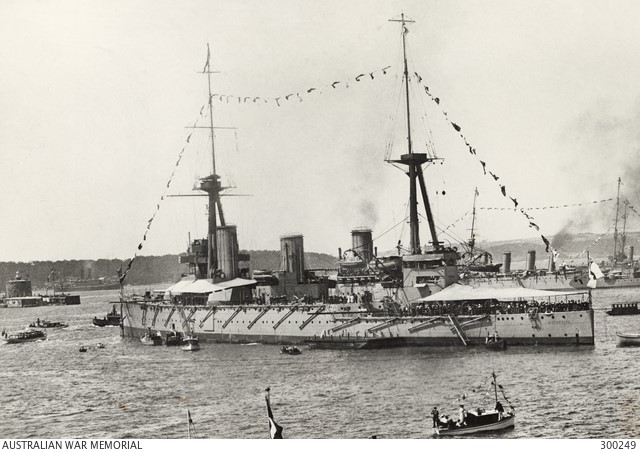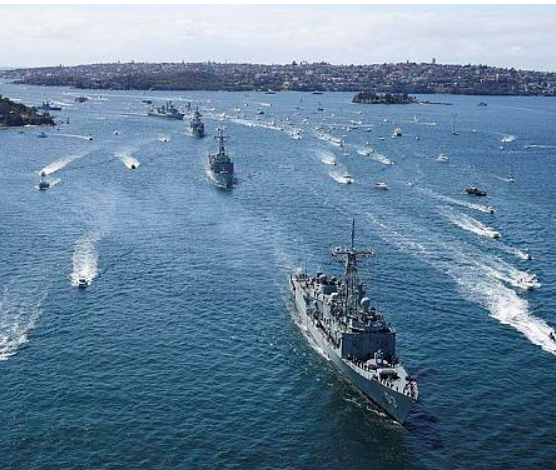- Author
- Haken, J.K., Dr
- Subjects
- History - general, Australian Warships
- Tags
-
- RAN Ships
- None noted.
- Publication
- March 2023 edition of the Naval Historical Review (all rights reserved)
By Dr J.K. Haken
A Fleet Review is a British tradition where the monarch inspects the massed ships of the navy. It originally occurred when the fleet was mobilised for war, or for a ‘show of strength’ to discourage potential enemies. In Britain, Reviews of Battle Fleets have been traced back to the fourteenth century. King Edward III in June 1346 reviewed a Battle Fleet bound for France.
Since the 19th century Fleet Reviews are now held for commemorative and celebratory purposes such as the coronation of a monarch or for special royal jubilees or for occasions that perform the crucial historical function of revisiting certain past events in the history of the country. These Fleet Reviews include inviting other national navies to participate by sending vessels.
According to tradition, participating ships anchor in two or more lines with an open passage between them. Each ship is dressed overall with the flags and pennants of their country. As the reviewing vessel sails past, the ships’ companies give three cheers to the reviewing officials and officers and captain salute.
Australia has largely followed British practice, with the Royal Australian Navy (RAN) following the Royal Navy (RN). The entry of the first RAN Fleet into Sydney Harbour on 4 October 1913, although somewhat different from traditional reviews, can be considered the first RAN Fleet Review. This Fleet Review has been the subject of several later commemorative reviews. Fleet Reviews have also been held for other Australian celebratory occasions. All Fleet Reviews have been attended by the monarch’s representative, visiting royalty or official dignitary.
In 1859 the Australian Station of the RN was established to provide for the maritime defence of Australia and New Zealand. The colonies decided that more defence was required and the first Australian naval forces were formed in the colonies in the late 1860s in response to fears of an invasion. When the Commonwealth of Australia was formed on 1 January 1901 the various colonial navies, and their vessels, were amalgamated into the Commonwealth Naval Forces on 1 March 19011. The vessels from the colonies were near the end of their serviceable life and the maritime defence provided by the RN was considered insufficient for the unsettled times.
In the years that followed, there was debate in Australia and Britain as to whether Australia needed its own navy or should simply continue financing the Australian Station of the RN. In 1909 the Imperial Conference on Naval Defence recommended the establishment of an Australian Fleet Unit. It was advocated that the new Fleet Unit should consist of a battle cruiser, three light cruisers, six destroyers and three submarines, to be paid for and controlled by Australia and eventually manned entirely by Australians – a separate and independent Australian Navy. On 10 July 1911 King George V signed a Royal Warrant granting assent to the Australian Naval Forces with Navy Orders indicating the new designation RAN on 5 October 19112.

Most of the new fleet was to be built in the United Kingdom. The first new ship launched on 9 February 1910 was HMAS Parramatta, a River Class Torpedo Boat Destroyer, the second and sister ship was HMAS Yarra which was launched on 9 April 1910. Both were commissioned on 10 September 1910. Another sister ship HMAS Warrego was also built in the United Kingdom, disassembled, shipped to Australia, reassembled at Cockatoo Island and commissioned on 1 June 1912. The aim was to develop the skills of Australian workers so that they could build their own warships. HMAS Australia accompanied by HMAS Sydney arrived in Jervis Bay from the United Kingdom on 2 October 1913.
The fleet assembled in Jervis Bay and was led into Sydney Harbour on 4 October 1913 by the flagship Australia with the Admiral Commanding the Australian Fleet Rear Admiral G.E. Patey on board. Australia was followed by HMA Ships Melbourne, Sydney, Encounter, Warrego, Parramatta and Yarra into Sydney Harbour. Thus the new RAN fleet was finally displayed to the Australian public. Thousands of people came out to view the fleet. The formation of the RAN and its fleet, funded and managed by Australians, for Australians – was widely recognised as signalling Australia’s maturity as a self-governing nation.
In addition, the RAN participated in Royal Naval Reviews held in England. These were the 1935 King George V Jubilee Review on 16 July 1935 attended by HMA Ships Australia (II) and Brisbane (I) and the 1977 Queen Elizabeth II Jubilee Review on 28 June 1977 attended by HMA Ships Melbourne (II) and Brisbane (II). The RAN was not involved in either of the 1911 King George V and 1937 King George VI Coronation Reviews.
Following is a list of some Australian Fleet Reviews:
Port Phillip Royal Review, 26 May 1920 – this was the RAN’s first real Fleet Review – the fleet of 28 vessels was inspected by Prince Edward, Prince of Wales.
50th Year Review, 1961
The 75th Fleet Review, 1986. Led by USS Missouri, reviewed by Prince Philip, Duke of Edinburgh.
Bicentennial Naval Salute, 1988. Led by USS New Jersey
Sydney Freedom of Entry Review, 14 March 2009 – The fleet review also consisted of a Freedom of Entry parade in Sydney.
International Fleet Review, 4–5 October 2013 – the Centenary of the Royal Australian Navy’s First Fleet arrival in Sydney Harbour.
One of the largest Fleet Reviews was the Bicentennial Naval Salute 1988 which was held on Sydney Harbour on 1 October 1988 as part of Australia’s Bicentennial Celebrations held over the period 28 September to 3 October3. The Bicentennial Naval Salute 1988 coincided with the 75th Anniversary of the entry of the first RAN Fleet into Sydney Harbour. The review was conducted by their Royal Highnesses, the Duke and Duchess of York on board HMAS Cook, oceanographic vessel, the review vessel. The ships were led by the battleship USS New Jersey. Participation was by 16 nations and involved 54 ships, details of the number of ships present from each nation are shown in the table below.
| Nation | Ships |
| Australia | 20 |
| France | 3 |
| Greece | 1 |
| India | 1 |
| Italy | 1 |
| Japan | 3 |
| Malaysia | 2 |
| The Netherlands | 4 |
| New Zealand | 3 |
| Nigeria | Personnel Only |
| Pakistan | 2 |
| Papua New Guinea | 2 |
| Solomon Islands | 1 |
| United Kingdom | 6 |
| United States | 4 |
| Vanuatu | 1 |
| Total of Ships | 54 |
After the Fleet Review, a flypast of Royal Australian Air Force and visiting aircraft was witnessed followed by a flypast of Qantas aircraft. In the evening there was a fireworks display.
The next Fleet Review was the centenary of the entry and possession of the first RAN fleet. It was commemorated by a series of events4 held over the period 28 September to 11 October 2013. The program, in addition to the Fleet Entry and Review, included a parade of tall ships and many events featuring the RAN. With the RAN contribution some 40 warships took part.

The fleet assembled in Jervis Bay (as did the First RAN Fleet in 1913) and entered Sydney Harbour on 4 October 2013 led by Sydney. The procession was greeted from Bradleys Head by the Governor General Quentin Bryce accompanied by HRH Prince Harry (later the Duke of Sussex). The fleet was reviewed the next day on 5 October 2013 by Governor-General Quentin Bryce and Prince Harry, who took the royal salute on board HMAS Leeuwin.
Table 2 shows nations that participated in the Fleet Review. The name and class of each naval ship is given while Table 3 shows similar information of non-naval participants.
The first Fleet Review of the RAN’s vessels was to show to the Australian population that we now had an Australian naval fleet that could protect our island home. Mobilisation for war and a ‘show of strength’ to discourage potential enemies or in the case of our First Review to give confidence to the nation were the original reasons for a Fleet Review but now a Fleet Review has become one of celebration, commemoration, and international cooperation rather than a purely militaristic activity displaying the size of your fleet. The 1988 Fleet Review was a celebration of Australia turning 200 years old and the 2013 Review was a commemoration of our navy turning 100 years old. Fleet Reviews now invite navies of other countries to participate and these invitations to other countries to join in the celebrations and commemorations helps to build global maritime partnerships and foster good relations with other countries.
Table 2. Details of Naval Ships
| Nation | Name of Ship | Class of Ship |
| Australia | 20 Ships | Various |
| Brunei | KDS Daruiaman | Patrol Boat |
| China | PLANS Quingado | Destroyer |
| France | Vendemiaire | Frigate |
| India | INS Sahyadi | Frigate |
| Indonesia | KRI Sultan Iskandar Muda | Corvette |
| Japan | JS Makinami | Destroyer |
| Malaysia | KB Jebat | Frigate |
| New Zealand | HMNZS Te Maria | Frigate |
| Nigeria | NNS Thunder | Patrol Boat |
| Singapore | RSS Endeavor | Amphibious Transport Dock |
| Spain | Cantibria | Replenishment Ship |
| Thailand | HTMS Krabi | Patrol Boat |
| United Kingdom | HMS Daring | Destroyer |
| United States | USS Chosan | Cruiser |
Table 3. Details of Non-Naval Ships
| Nation | Name of Ship | Class of Ship |
| Australia | 10 Ships | Tall Ship |
| Australia | Lady Hopetoun* | Steam Launch |
| Australia (a) | Ex HMAS Advance§ | Patrol Boat |
| Cook Islands | Picton Castle | Tall Ship |
| Netherlands | Osterschelde | Tall Ship |
| Netherlands | Europa | Tall Ship |
| Netherlands | Tecla | Tall Ship |
| New Zealand | Spirit of New Zealand | Tall Ship |
| United Kingdom | STS Lord Nelson | Tall Ship |
*The steam launch Lady Hopetoun also participated in the event of 1913.
- HMAS Advance was decommissioned on 6 February 1988, donated to the Australian National Maritime Museum who have maintained it operationally.
References:
Commonwealth of Australia Gazette No 91 20.2.1901.
Navy Order 77/1911
Australian Bicentennial Authority Official Publication: Bicentennial Naval Salute. Australian Bicentennial Authority 1988 106 pp
International Fleet Review Schedule of Events. RAN 2013
Welcome to the Ryde Social Heritage Group Website – RSHG
The Australian Navy and the 1909 Imperial Conference on Defence
The Royal Australian Navy fleet entry of 1913. Australian War Memorial (awm.gov.au)
The RAN – A Brief History – Royal Australian Navy
Origins of Fleet Reviews – National Museum of the Royal New Zealand Navy (navymuseum.co.nz)
Backgrounder: International Fleet Review – Canada.ca
International Fleet Review 2013 – Wikipedia




